|
Standing Bear Park, October
2005
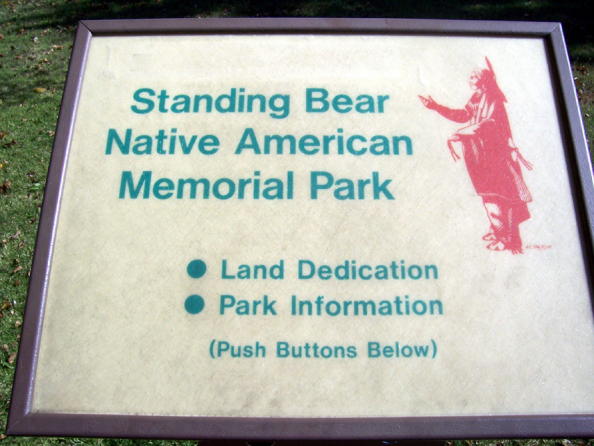
Sign at Entrance of Standing Bear Park, Ponca City, Oklahoma.
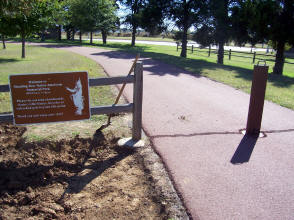
Entrance at the corner of highway 177, and 60 that come east off
Interstate 35.
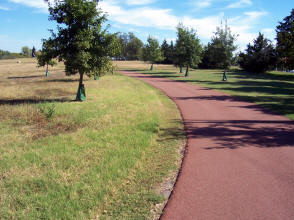
At the beginning the tour around the park with young trees planted along
trails and walkways. Standing Bear statue is in the background. If you
look closely you can see the grass is mown lower up close to the walk This
is native Buffalo grass and is allowed to grow in order to create a
natural terrain.
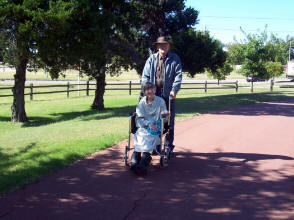
Rhonda, my daughter, and Rodney, her father, starting their walk around
the park. It was a beautiful day and Rhonda enjoys brief outings like
this.
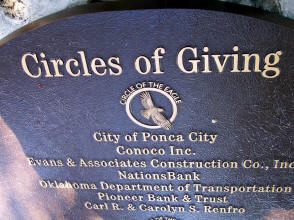
Below this plaque are the names of citizens who donated sizable monetary
gifts for the building of this park in memory of a great chief, Standing
Bear, who returned to his native home along the Neobrara in Nebraska. His
son died and had asked his father to return his heart to their home in the
North. This is what Standing Bear did. He took a small band of Poncas and
they made the trek back during winter. Tibbles is the author of the book
"Trial of Standing Bear." My brother Dan Jones found the stroy in the
archives at Washington, D.C., brought the material back and produced the
documentary which was shown nationally on PBS some years ago. Many
people, myself included, knew nothing of this story until we saw the
enactment of that history on the screen.

This statue of Chief Standing Bear is looking out into the distance and to
where the clans are listed on the ground. A reflective pool with an
everlasting flame in the center honors the spot. The voice box tells the
story of how Standing Bear said, "My skin is not the color of your skin,
but if I pierce it would we not bleed the same color?"

This is looking down onto the walkway where the clans are recorded. This
one is for the Rain clan, my grandmother's band.
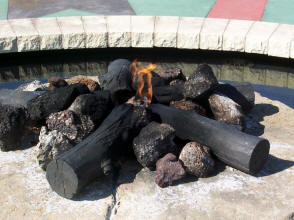
The everlasting flame burns here in the middle of this circle.
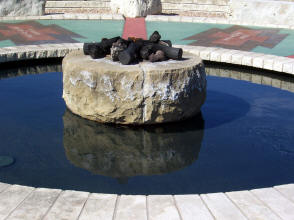
Here you see a close up shot of the round stone in the middle of the
reflective pool under the statue of Chief Standing Bear.
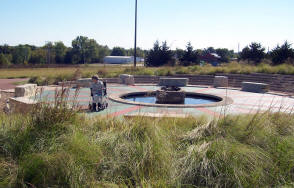
Rhonda enjoyed pushing her wheelchair around this circular area beneath
the statue where the reflective pool is surrounded by rustling Buffalo
grass. The warm, bright sunny day was especially nice since this is
approaching November.
The next segments of
photographs will show the obelisks and markers in their own circular area
where voice boxes tell about each of the five tribes, Ponca, Osage, Kaw,
Otoe-Missouri and Tonkawa.
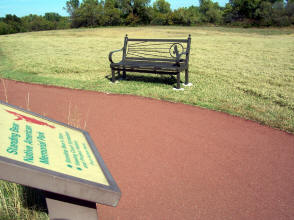
This is a more recent addition; the steel park benches which are located
around the trails.
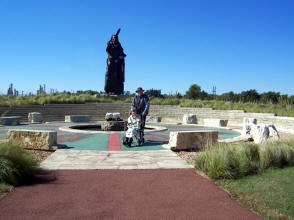
Here is my daughter, Rhonda and her Dad again, around the base of the
Standing Bear statue. This circular base is where the remaining 7 or 8
remaining clans of the original twelve are recorded. I wrote the clans
down when an elder in 1975 gave them to me. Today, I have not been able to
find these clans through research, not here and not in Nebraska. However,
I know there were twelve because this is in agreement with the original
twelve chiefs over tribe. Also, I remember Grandmother speaking of some
that are no longer in existence.
This is a landscape view showing the refinery in the background. The tall
Native Buffalo grass is shown growing beneath the base of the Statue and
again in the foreground at the entry into the circle.

The landscape shows one of the circular memorial spots. This one is in
honor of the Tonkawa tribe. The voice box on a low pedestal is shown
here. One can listen to the story and then read about it on the obelisks
you see here. An engraving is in a shadow like image which is not easily
seen unless a person stands up close.
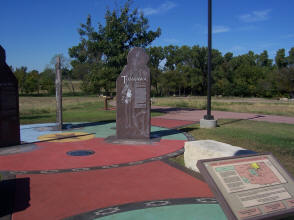
This is a closer view of the Obelisks. You can see the shadow like
engraving here if you click on this photograph to enlarge. A side view of
the flat stone shows that they are thin and almost look like a pole. The
arrwork is seen around the circular floor.
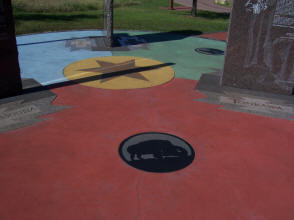
Again a shot of the floor on the circle showing the color and symbols of a
buffalo and a star. I can't remember any stars in our symbolism, but there
are other small irregularities set in stone. The over all beauty of the
park is quiet and serene and gives a great amount of solace to Native
American to whom this is dedicated. Since Grandmother's name has the word
"star" in it, not to complain.
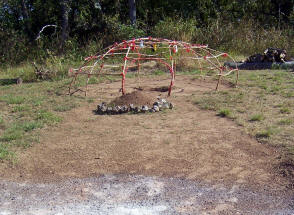
The circular frame for the sweat lodge remains here. The sweat is
something practiced by the Native people. It is a spiritual ritual health
practice which, after all, is what religion is intended to achieve.
Cleansing of the body through the spa like atmosphere where sage and heat
removes impurities from the skin is practiced along with prayer for a
cleansing of the mind, as well. This practice which was simple in the
beginning has been joined with a combination and melting of various
cultures and practices. The circular symbol can be seen at the entrance.
In the background to the right is a stack of wood used to keep the fire
going in the pit of the sweat lodge. What is that white outline in the
background on the left? Behind the frame of the sweat lodge are tall
stems of Johnson grass. This grass was brought into Oklahoma by cattle. It
is an invasive plant with roots going deep into the ground. If it isn't
controled it will totally destroy the native grasses of the prairie. On
the roads going into the grass lands the ranchers see to it the road
workers keep it off the highway because they are aware of how quickly it
can destroy the tallgrass.
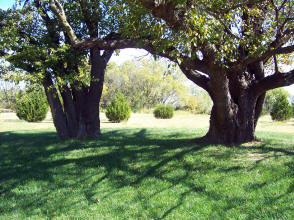
These two beautiful old trees were saved from the dozer's blade and is
where weddings can be performed for that genre who loves the
outdoor ceremony.
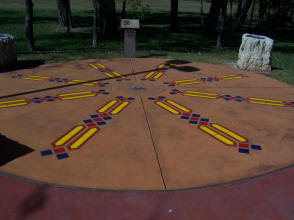
Landscape shot of the ground on the circle for Kaw Tribe
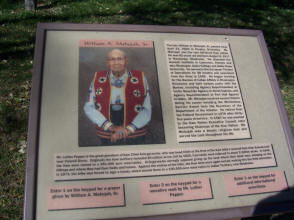
Close up of the last Kaw tribe member, William Mehojah. Click to enlarge
so you can read the interesting text.
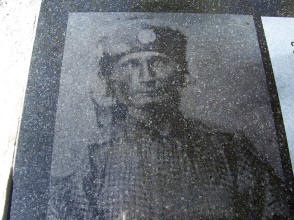
Picture of Chief Al-Le-Ga-Wa-Ho. His grandson, Luther Pepper, narrates
on the voice box and it is special to hear the proper pronounciation of
the Chief's name. I try to go through this park often to purposely focus
on just one area of the five tribes. There is too much to absorb on the
total history of the park. It is also has been a priviledge to meet the
descendant of this chief, Mr. Pepper, because he looks like he has stepped
out of a history book with the countenance and bearing of his ancestor. |
